Tissues Class 9 Notes Science Chapter 6
| Table of contents |

|
| Introduction |

|
| Are Plants and Animals Made of the Same Types of Tissues? |

|
| Plant Tissues |

|
| Animal Tissues |

|
Introduction
All living organisms are made up of cells, which are the basic units of structure and function in life. In unicellular organisms like Amoeba, a single cell performs all essential functions, including movement, food intake, gaseous exchange, and excretion.
- Specialized Cells in Multicellular Organisms: In multicellular organisms, there are millions of specialized cells, each designed to perform a specific task efficiently.
- For example, in humans, muscle cells help in movement by contracting and relaxing, nerve cells carry messages across the body, and blood cells transport oxygen, nutrients, hormones, and waste materials. In plants, vascular tissues transport food and water from one part of the plant to another.
- A tissue is a group of similar cells working together to perform a specific function. For instance, blood transports essential materials, phloem moves food in plants, and muscle tissues aid in movement. Tissues are organized in a way that maximizes their efficiency in performing specific roles.
 Tissue
Tissue
Are Plants and Animals Made of the Same Types of Tissues?
Plants and animals are made up of different types of tissues, each serving specific roles that match their way of life.
1. Structure and Movement:
- Plants: Plants stay in one place and need a strong structure to support themselves. Their supportive tissues mainly consist of dead cells.
- Animals: Animals are mobile, moving around to find food, mates, and shelter. Their tissues are mostly living and specialised, allowing for movement and flexibility.
2. Growth Patterns:
- Plants: Plants grow in specific areas called meristems, where new cells are formed continuously. Once certain parts mature, they stop growing.
- Animals: In contrast, animals grow more evenly, without clear areas of active and inactive cell division.
3. Complexity and Specialisation:
- Plants: Plant tissues are divided into two main categories: meristematic and permanent. Meristematic tissue is for growth, while permanent tissues include simple types (like parenchyma, collenchyma, and sclerenchyma) and complex types (such as xylem and phloem).
- Animals: Animal tissues are classified into four main types: epithelial, connective,muscular, and nervous tissues. Epithelial tissue is further divided based on shape and function into squamous, cuboidal, columnar, ciliated, and glandular types. Connective tissues consist of areolar, adipose, bone, tendon, ligament, cartilage, and blood. Muscle tissues include striated, unstriated, and cardiac types. Nervous tissue is made up of neurons that transmit signals.
Plant Tissues
Plant tissues are classified into two main types: meristematic and permanent.
- Meristematic Tissue: This is the dividing tissue present in the growing regions of the plant.
- Permanent Tissues: These are derived from meristematic tissue once they lose the ability to divide. Permanent tissues are further classified into simple and complex tissues.
The three types of simple tissues are:
- Parenchyma
- Collenchyma
- Sclerenchyma
The two types of complex tissues are:
- Xylem
- Phloem

1. Meristematic Tissue
- Meristematic tissue is the growth tissue found in the areas of the plant that are still developing. The growth of plants happens in specific areas because of this special tissue that divides.
- These cells are small, round, or polygonal with dense cytoplasm. They are very active and have thin cellulose walls and noticeable nuclei. They do not have vacuoles.
Meristematic tissues can be classified based on their location:
- Apical Meristem: Found at the tips of stems and roots, this type increases the length of both.
- Lateral Meristem (cambium): Located on the sides of stems and roots, it helps to thicken them.
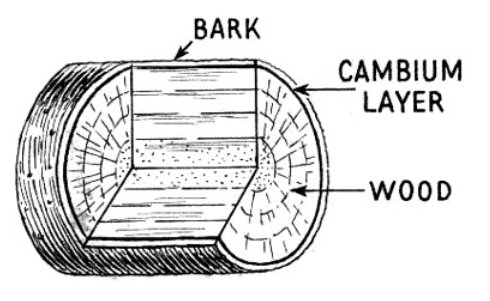
Intercalary Meristem: Found near the nodes (the points on a stem where leaves or branches grow). It contributes to the length between two nodes.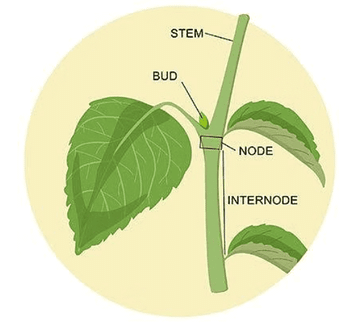

2. Permanent Tissues
- Permanent tissues come from meristematic cells that can no longer divide. These cells change to take on specific roles. They can be either living or dead, and their walls can be thin or thick, with the thickening being either regular or irregular.
- Permanent tissues are further divided into two main groups: Simple Permanent Tissue and Complex Permanent Tissue.
Simple Permanent Tissue
A few layers of cells beneath the epidermis are generally known as simple permanent tissue.
This type consists of one kind of cell that serves the same function. The three types of simple tissues are:
- Parenchyma
- Collenchyma
- Sclerenchyma
Complex permanent tissues are made up of more than one type of cell and include:
- Xylem
- Phloem
(a) Parenchyma
- Parenchyma cells are thin-walled, living cells that make up the basic packing tissue of all plant parts. They can be oval, spherical, or polygonal in shape, and are loosely arranged with small and large spaces in between. Their main role is to store food.
- When parenchyma contains chlorophyll, it is called chlorenchyma, which is important for photosynthesis.
- In aquatic plants, parenchyma cells have large air spaces that help store gases and keep the plants afloat. This special type of parenchyma is known as aerenchyma.
 Parenchyma Tissues in Transverse and Longitudinal Section
Parenchyma Tissues in Transverse and Longitudinal Section
(b) Collenchyma
- Collenchyma cells are living cells with thickened corners. The uneven thickness of their walls gives mechanical support and flexibility to the plant, allowing it to bend without breaking.

(c) Sclerenchyma
- Sclerenchyma cells are usually dead, thick, and have tough walls. They have a narrow space inside. There are two types of sclerenchyma:
- Fibres, which are long and spindle-shaped with pointed ends.
- Sclereids, which are shorter and broader cells, sometimes called stone cells. This type of tissue provides strong support and helps plants withstand various stresses.
 Sclerenchyma Tissue
Sclerenchyma Tissue
(d) Epidermis
- The epidermis is the outer protective layer of plant parts that stops pathogens and pests from entering.
- Epidermal cells are elongated and tightly packed, generally having thick outer and side walls, while the inner walls are thinner.
- The thick outer walls contain a fatty substance called cutin, which makes them waterproof.
- In some plants, like those in deserts, the epidermis has a thick waxy coating of cutin on its outer surface.
- Root epidermal cells, which help absorb water, often have long hair-like extensions that increase the area available for absorption.
- Typically, the epidermis is a single layer but has small openings called stomata that allow gas exchange. These are surrounded by two guard cells.
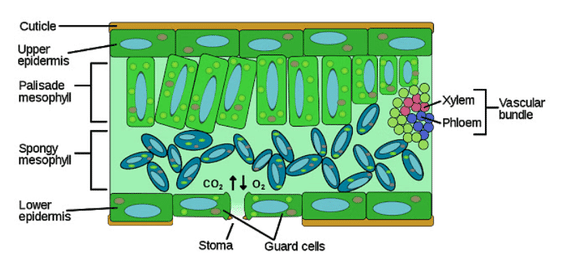 EpidermisWater loss in the form of vapour, known as transpiration, also occurs through stomata. As plants age, the outer protective layer changes. A strip of secondary meristem in the cortex forms layers of cells called cork. Cork cells are dead, tightly packed without spaces, and contain a substance called suberin, making them impermeable to gases and water.
EpidermisWater loss in the form of vapour, known as transpiration, also occurs through stomata. As plants age, the outer protective layer changes. A strip of secondary meristem in the cortex forms layers of cells called cork. Cork cells are dead, tightly packed without spaces, and contain a substance called suberin, making them impermeable to gases and water. - Epidermal cells of roots have long, hair-like structures called root hairs. These hairs help increase the surface area for better absorption of water and minerals from the soil.
- On many plants, the outer surface has trichomes, which are hair-like extensions of the epidermis. These can be glandular or non-glandular and create a layer of still air on the surface, which provides insulation.
- Cork is the outer protective layer found on older stems and roots. It arises from a type of lateral meristem known as cork cambium.
- The cork cambium generates a secondary layer called phelloderm on the inside and cork or phellem on the outside.
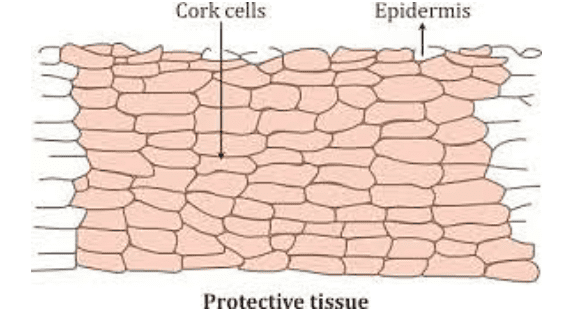
- Cork cells are dead and tightly packed, lacking intercellular spaces. Their walls contain a substance called suberin, which makes them resistant to gases and water.
- Some cork cells have small openings called lenticels, which allow for gas exchange.
- Older cork cells die and fill with substances like tannins, resins, and air.
(ii) Complex Permanent Tissues
Complex permanent tissues consist of multiple cell types working together for a specific function.
These tissues are mainly divided into two types:
(a) Xylem
- Xylem is a complex tissue that is crucial for transporting water and minerals from the soil to different parts of the plant through the roots. It includes tracheids, xylem vessels, xylem fibres, and xylem parenchyma.
- Dead tubular tracheids and xylem vessels assist in moving water from roots to shoots. Living xylem parenchyma stores food.
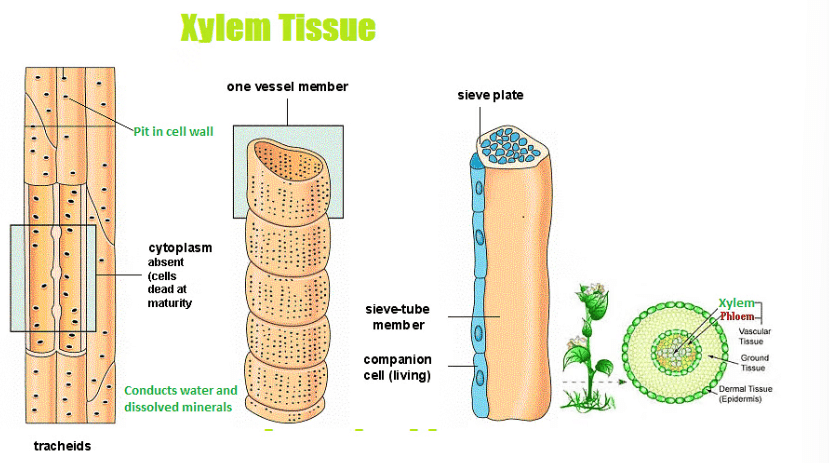
- Dead xylem fibres provide structural support. Vessels are long tubes formed by the end-to-end joining of many dead cells, with lignified walls that have pits.
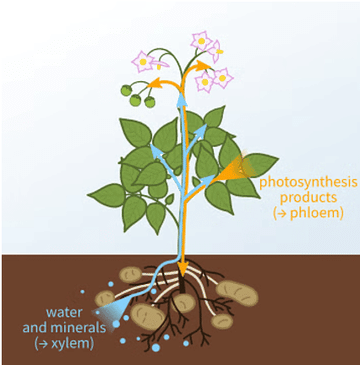 Working of Xylem and Phloem in plant
Working of Xylem and Phloem in plant
(b) Phloem
- Phloem consists of five cell types: sieve cells, sieve tubes, companion cells, phloem fibres, and phloem parenchyma.
- Sieve tubes are tubular cells with holes in their walls that transport food from the leaves to other parts of the plant. All phloem cells, except for phloem fibres, are living cells.
- Phloem is the tissue responsible for transporting food that is made in leaves to other areas of the plant. It consists of five types of cells:
- Sieve cells
- Sieve tubes
- Companion cells
- Phloem fibers
- Phloem parenchyma
All the cells in the phloem are living, except for the phloem fibres. The main function of phloem is to transport food from the leaves to other parts of the plant, which is essential for the plant's nutrition and growth.
 |
Download the notes
Chapter Notes: Tissues
|
Download as PDF |
Animal Tissues
Animal tissues are groups of cells that have similar structures and functions, working together to carry out specific tasks in the bodies of animals. These tissues can be divided into four main types based on their structure and function: epithelial tissue, connective tissue, muscular tissue, and nervous tissue.
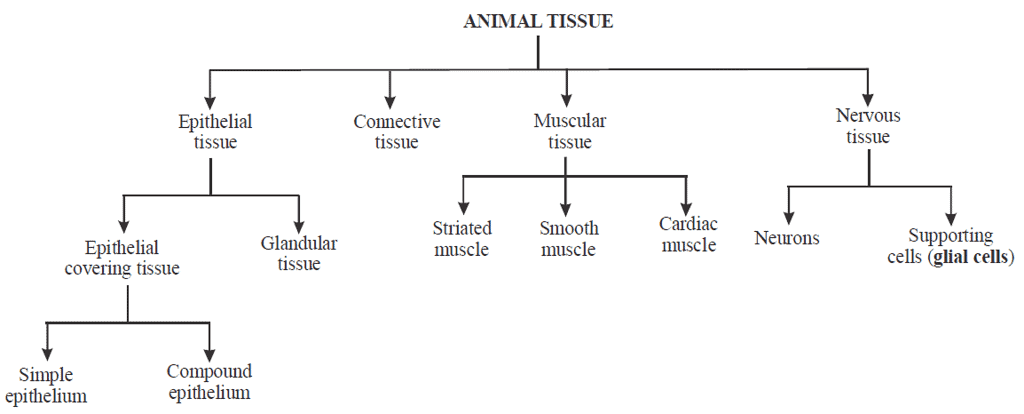
Epithelial Tissues in Animals
Definition: Epithelial tissues are the protective coverings in the animal body.
Functions:
- Cover the majority of organs and cavities in the body.
- Create barriers to separate different body systems.
- Control the exchange of materials between the body and the outside environment.
Locations: Skin, lining of the mouth, lining of blood vessels, alveoli in lungs, kidney tubules.
Characteristics:
- Cells are tightly packed, forming a continuous layer.
- There is minimal cementing material between cells and almost no spaces.
- All substances entering or leaving the body must pass through at least one layer of epithelium.
- Epithelial tissue is classified by shape and function into several types, including cuboidal, columnar, ciliated, and glandular.
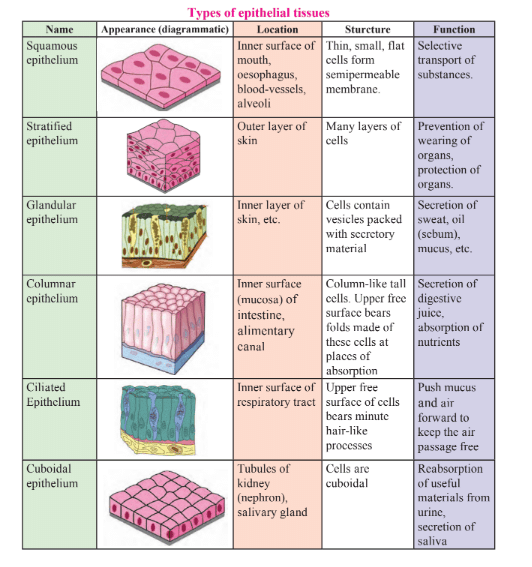
Connective Tissue
Connective tissues are identified by loosely spaced cells within a matrix that can be jelly-like, fluid, dense, or rigid, depending on the tissue's purpose. Types of connective tissues in our body include:
- Areolar tissue
- Adipose tissue
- Bone
- Tendon
- Ligament
- Cartilage
- Blood
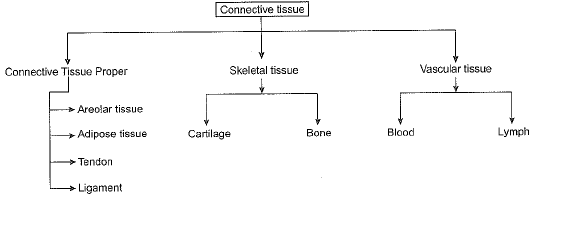
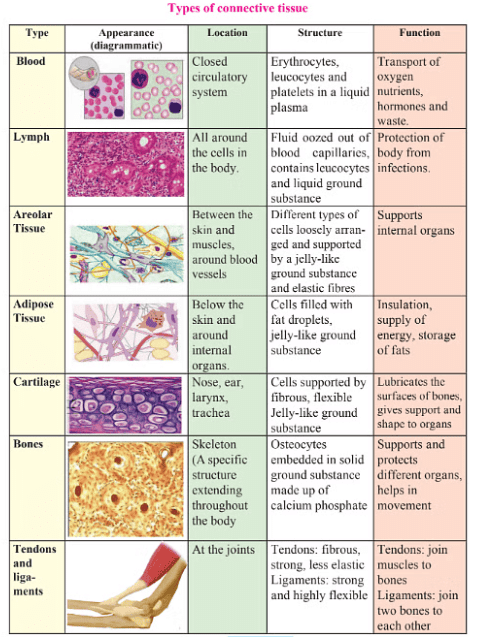
Muscular Tissue
Definition: Muscular tissue is made up of long cells known as muscle fibres, which are responsible for movement.
Special Proteins: These tissues contain proteins that enable muscles to contract and relax, allowing movement.
Types of Muscular Tissue:
- (i) Skeletal Muscles (Striated Muscles):
- Function: Enables voluntary movements, like moving limbs.
- Characteristics:
- Attached to bones to facilitate body movement.
- Under a microscope, these muscles display alternating light and dark bands (striations).
- Cells are long, cylindrical, unbranched, and have multiple nuclei.
- (ii) Smooth Muscles (Unstriated Muscles):
- Function: Controls involuntary movements, such as food movement in the digestive tract and blood vessel contraction.
- Locations: Found in the eye's iris, ureters, bronchi of the lungs, and more.
- Characteristics:
- Cells are spindle-shaped and have a single nucleus.
- These muscles do not have striations, hence called unstriated.
- (iii) Cardiac Muscles:
- Function: Regulates the rhythmic contraction and relaxation of the heart.
- Characteristics:
- Cells are cylindrical, branched, and have one nucleus.
- These muscles operate involuntarily, without conscious control.
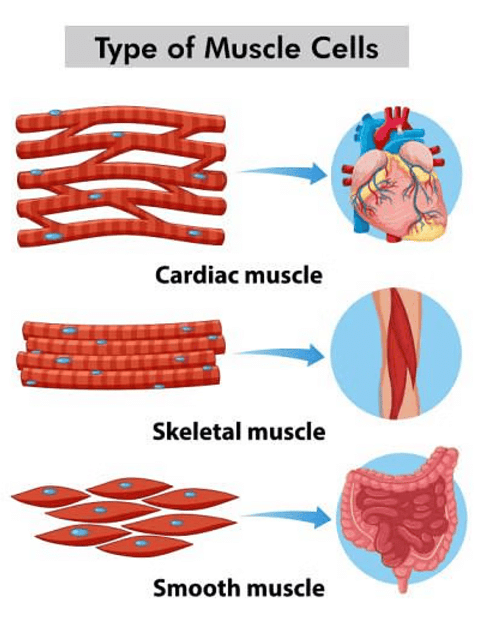
Voluntary vs. Involuntary Muscles
- Voluntary Muscles: These muscles can be moved by our conscious will. They are found in our limbs and we can decide when to move them or stop.
- Involuntary Muscles: These muscles work automatically without us having to think about it (for example, smooth and cardiac muscles). They are located in various parts of the body, such as the iris of the eye, ureters, and bronchi of the lungs.
Nervous Tissue
- Nervous tissue plays a key role in fast communication within the body and is made up of neurons.
- These cells are highly specialised to be stimulated and quickly send messages from one part of the body to another.
- It includes the brain, spinal cord, and nerves.
Neurons (Nerve Cells)
- Structure: A neuron has a cell body that contains the nucleus and cytoplasm, with long, thin, hair-like parts extending from it.
- Axon: This is a single long extension responsible for sending signals.
- Dendrites: These are many short, branched extensions that receive signals.
- Length: A single neuron can be as long as a meter.
- A neuron consists of a cell body, dendrites, and axons, which allow it to transmit nerve impulses.

|
84 videos|384 docs|61 tests
|
FAQs on Tissues Class 9 Notes Science Chapter 6
| 1. What are the main types of tissues found in plants and animals? |  |
| 2. How do plant tissues differ from animal tissues in terms of structure and function? |  |
| 3. What is the role of meristematic tissue in plants? |  |
| 4. Can you explain the different types of connective tissues in animals? |  |
| 5. Why is understanding tissues important in biology? |  |




























